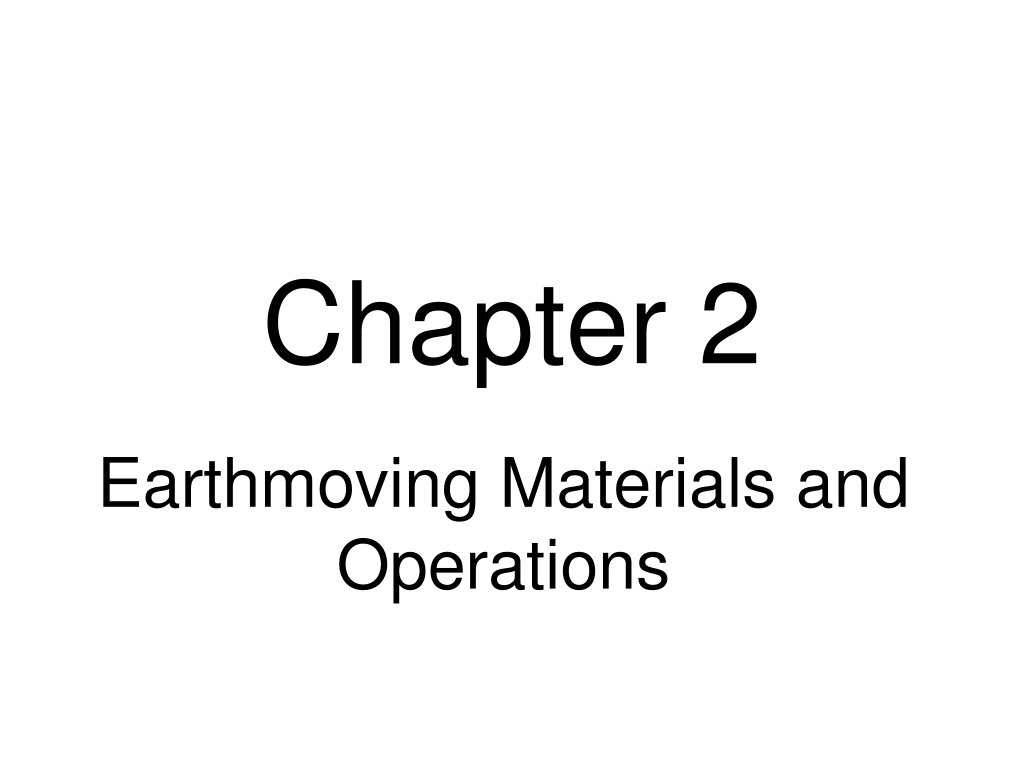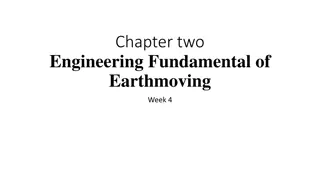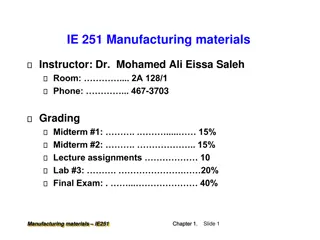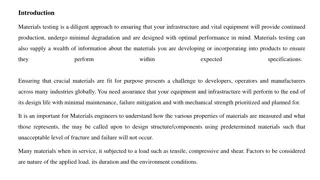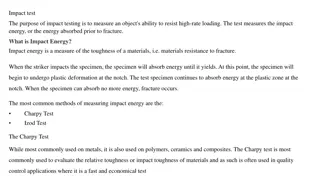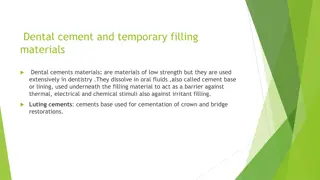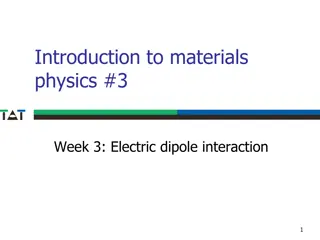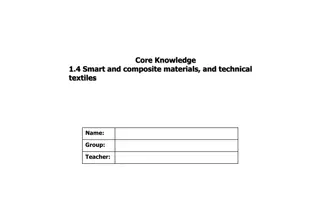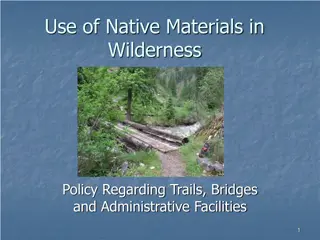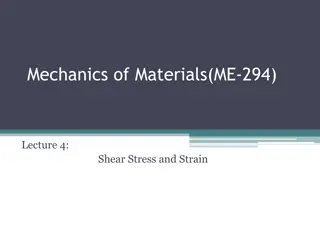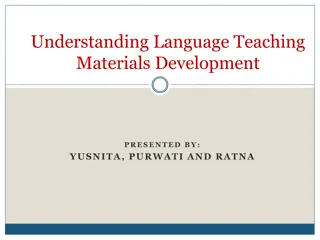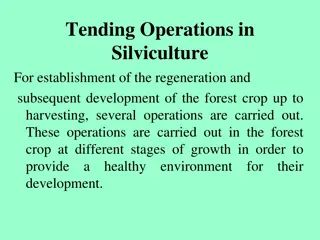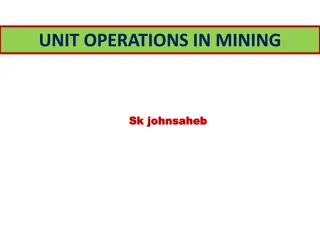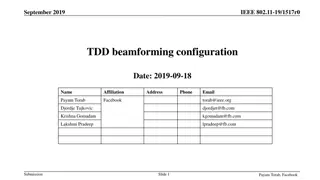Understanding Earthmoving Materials and Operations
Earthmoving involves the process of moving soil or rock to meet construction requirements. This includes activities such as excavating, loading, hauling, compacting, grading, and finishing. Efficient management requires accurate estimating of work quantities, proper equipment selection, and competent job management. Cost calculations and job efficiency estimation methods are essential for successful earthmoving operations.
Uploaded on Sep 23, 2024 | 0 Views
Download Presentation

Please find below an Image/Link to download the presentation.
The content on the website is provided AS IS for your information and personal use only. It may not be sold, licensed, or shared on other websites without obtaining consent from the author. Download presentation by click this link. If you encounter any issues during the download, it is possible that the publisher has removed the file from their server.
E N D
Presentation Transcript
Chapter 2 Earthmoving Materials and Operations
2-1 INTRODUCTION TO EARTHMOVING The Earthmoving Process Equipment Selection Production of Earthmoving Equipment
The Earthmoving Process Earthmoving is the process of moving soil or rock from one location to another and processing it so that it meets construction requirements of location, elevation, density, moisture content, and so on.
The Earthmoving Process Activities involved in this process include : excavating, loading, hauling, placing (dumping and spreading), compacting, grading, and finishing.
The Earthmoving Process The construction procedures and equipment involved in earthmoving are described in Chapters 3 to 6. Efficient management of the earthmoving process requires : accurate estimating of work quantities and job conditions, proper selection of equipment, and competent job management. Production = Volume per cycle Cycles per hour (2-1)
Production of Earthmoving Equipment The cost per unit of production may be calculated as follows: Cost per unit of production = Equipment cost per hour Equipment production per hour. (2-2) Methods for determining the hourly cost of equipment operations are explained in Chapter 17.
Production of Earthmoving Equipment There are two principal approaches to estimating job efficiency in determining the number of cycles per hour to be used in Equation 2-1. One method is to use the number of effective working minutes per hour to calculate the number of cycles achieved per hour. This is equivalent to using an efficiency factor equal to the number of working minutes per hour divided by 60.
2-2 EARTHMOVING MATERIALS General Soil Characteristics Soil and Rock
General Soil Characteristics Several terms relating to a soil's behavior in the construction environment should be understood. Trafficability. Loadability.
General Soil Characteristics Trafficability : is the ability of a soil to support the weight of vehicles under repeated traffic (equipment within the construction area) . Trafficability is primarily a function of: soil type and moisture conditions.
General Soil Characteristics Loadability: It is a measure of the difficulty in excavating and loading a soil. Loose granular soils are highly loadable. whereas compacted cohesive soils and rock have low loadability.
General Soil Characteristics Moisture content (%) = (Moist weight - Dry weight) / Dry weight 100 If, for example, a soil sample weighed 120 lb (54.4 kg) in the natural state and 100 lb (45.3 kg) after drying, the weight of water in the sample would be 20 lb (9.1 kg) and the soil moisture content would be 20%. Using Equation 2-3, this is calculated as follows: Moisture content = (120 100)/100 100 = 20% [= (54.4 - 45.3) / 45.3 100 = 20%] (2-3)
2-4 SOIL VOLUME-CHANGE CHARACTERISTICS Soil Conditions Swell Shrinkage Load and Shrinkage Factors
Soil Conditions There are three principal conditions or states in which earthmoving material may exist: bank, loose, and compacted. Bank: Material in its natural state before disturbance. Often referred to as "in-place" or "in situ." A unit volume is identified as a bank cubic yard (BCY) or a bank cubic meter (BCM).
Soil Conditions Loose: Material that has been excavated or loaded. A unit volume is identified as a loose cubic yard (LCY) or loose cubic meter (LCM). Compacted: Material after compaction. A unit volume is identified as a compacted cubic yard (CCY) or compacted cubic meter (CCM).
Swell A soil increases in volume when it is excavated because the soil grains are loosened during excavation and air fills the void spaces created. As a result, a unit volume of soil in the bank condition will occupy more than one unit volume after excavation. This phenomenon is called swell. Swell may be calculated as follows: Swell (%) = (Weight/bank volume Weight/loose volume 1) 100 (2-4)
EXAMPLE 2-1 Find the swell of a soil that weighs 2800 lb/cu yd (1661 kg/m3) in its natural state and 2000 lb/cu yd (1186 kg/m3) after excavation. Solution Swell = (2800/2000 1) 100 =40% [= (1661/1186 1) 100=40%] That is, 1 bank cubic yard (meter) of material will expand to 1.4 loose cubic yards (meters) after excavation.
Shrinkage When a soil is compacted, some of the air is forced out of the soil's void spaces. As a result, the soil will occupy less volume than it did under either the bank or loose conditions. This phenomenon, which is the reverse of the swell phenomenon, is called shrinkage.
Shrinkage The value of shrinkage may be determined as follows: Shrinkage (%) = (1 Weight/bank volume Weight/compacted volume) 100 (2-5) Soil volume change due to excavation and compaction is illustrated in Figure 2-2. Note that both swell and shrinkage are calculated from the bank (or natural) condition.
EXAMPLE 2-2 Find the shrinkage of a soil that weighs 2800 lb/cu yd (1661 kg/m3) in its natural state and 3500 lb/cu yd (2077 kg/m3) after compaction. Solution Shrinkage = (1 2800/ 3500) 100 = 20% (Eq 2-5) [= (1 1661/ 2077) 100 = 20%] Hence 1 bank cubic yard (meter) of material will shrink to 0.8 compacted cubic yard (meter) as a result of compaction.
Load and Shrinkage Factors A pay yard (or meter) is the volume unit specified as the basis for payment in an earthmoving contract. It may be any of the three volume units.
Load and Shrinkage Factors A soil's load factor may be calculated by use of Equation 2-6 or 2-7. Load factor = Weight/loose unit volume Weight/bank unit volume (2-6) or Load factor = 1/ (1+swell) (2-7) Loose volume is multiplied by the load factor to obtain bank volume.
Load and Shrinkage Factors A factor used for the conversion of bank volume to compacted volume is sometimes referred to as a shrinkage factor. The shrinkage factor may be calculated by use of Equation 2-8 or 2-9. Shrinkage factor = Weight/bank unit volume Weight/compacted unit volume (2-8) or Shrinkage factor = 1 shrinkage (2-9)
Load and Shrinkage Factors Bank volume may be multiplied by the shrinkage factor to obtain compacted volume or compacted volume may be divided by the shrinkage factor to obtain bank volume.
EXAMPLE 2-3 A soil weighs 1960lb/LCY (1163kg/LCM), 2800lb/BCY(1661kg/BCM), and 3500 lb/CCY (2077 kg/CCM). a) Find the load factor and shrinkage factor for the soil. b) How many bank cubic yards (BCY) or meters (BCM) and compacted cubic yards (CCY) or meters (CCM) are contained in 1 million loose cubic yards (593,300 LCM) of this soil?
EXAMPLE 2-3 Solution (a) Load factor = 1960/2800 =0.70 [=1163/1661 =0.70] Shrinkage factor = 2800/3500 = 0.80 [= 1661/2077 = 0.80] (b) Bank volume = 1,000,000 0.70 = 700,000 BCY [= 593300 x 0.70 = 415310 BCM] Compacted volume = 700,000 0.80= 560,000 CCY [= 415310 0.80 = 332248 CCM] (Eq 2-6) (Eq 2-8)
Load and Shrinkage Factors Typical values of unit weight, swell, shrinkage, load factor, and shrinkage factor for some common earthmoving materials are given in Table 2-5.
2-5 SPOIL BANKS When planning and estimating earthwork, it is frequently necessary to determine the size of the pile of material that will be created by the material removed from the excavation. If the pile of material is long in relation to its width, it is referred to as a spoil bank. Spoil banks are characterized by a triangular cross section.
2-5 SPOIL BANKS If the material is dumped from a fixed position, a spoil pile is created which has a conical shape. To determine the dimensions of spoil banks or piles, it is first necessary to convert the volume of excavation from in-place conditions (BCY or BCM) to loose conditions (LCY or LCM).
2-5 SPOIL BANKS Bank or pile dimensions may then be calculated using Equations 2-10 to 2-13 if the soil's angle of repose is known.
Triangular Spoil Bank Volume = Section area x Length B = ( 4V/( L tan R)) H = B tan R /2 where B =base width (ft or m) H =pile height (ft or m) L =pile length (ft or m) R =angle of repose (deg) V =pile volume (cu ft or m3) (2-10) (2-11)
Triangular Spoil Bank Typical values of angle of repose for common soils are given in Table 2-6.
Conical Spoil Pile Volume = Base area Height D = (7.64V / tan R) H= D/2 tan R where D is the diameter of the pile base (ft or m). (2-12) (2-13)
2-5 SPOIL BANKS A soil's angle of repose is the angle that the sides of a spoil bank or pile naturally form with the horizontal when the excavated soil is dumped onto the pile. The angle of repose (which represents the equilibrium position of the soil) varies with the soil's physical characteristics and its moisture content.
EXAMPLE 2-4 Find the base width and height of a triangular spoil bank containing 100 BCY(76.5BCM)if the pile length is 30 ft (9.14 m), the soil's angle of repose is 37 , and its swell is 25%. Solution Loose volume =27 100 1.25 =3375 cu ft [= 76.5 1.25 = 95.6 m3] Base Width = (4 3375 /(30 tan 37o)) =24.4 ft (Eq 2-10) [=( 4 x 95.6 /(9.14 tan 37 )) =7.45 m] Height = 24.4/2 tan 37 =9.2 ft [= 7.45/2 tan 37 = 2.80 m] (Eq 2-11)
EXAMPLE 2-5 Find the base diameter and height of a conical spoil pile that will contain 100BCY (76.5 BCM) of excavation if the soil's angle of repose is 32 and its swell is 12%. Solution Loose volume = 27 100 1.12 = 3024 cu ft [= 76.5 1.12 85.7 m3] Base diameter = (7.64 3024 / tan 32o) =33.3 ft (Eq 2-12) [=(7.64 85.7 / tan 32 ) =10.16 m] Height = 33.3 /2 tan 32 = 10.4 ft [= 10.16 /2 tan 32 = 3.17 m] (Eq 2-13)
2-6 ESTIMATING EARTHWORK VOLUME When planning or estimating an earthmoving project it is often necessary to estimate the volume of material to be excavated or placed as fill. The procedures to be followed can be divided into three principal categories: 1) pit excavations (small, relatively deep excavations such as those required for basements and foundations), 2) trench excavation for utility lines, and 3) excavating or grading relatively large areas.
2-6 ESTIMATING EARTHWORK VOLUME Procedures suggested for each of these three cases will now be described. The estimation of the earthwork volume involved in the construction of roads and airfields is customarily performed by the design engineer. The usual method is to calculate the cross-sectional area of cut or fill at regular intervals (such as stations [l00 ft or 33 m]) along the centerline. The volume of cut or fill between stations is then calculated, accumulated, and plotted as a mass diagram.
2-6 ESTIMATING EARTHWORK VOLUME While the construction of a mass diagram is beyond the scope of this book, some construction uses of the mass diagram are described in Section 2-7. When making earthwork volume calculations, keep in mind that cut volume is normally calculated in bank measure while the volume of compacted fill is calculated in compacted measure. Both cut and fill must be expressed in the same volume units before being added.
Pit Excavations For these cases simply multiply the horizontal area of excavation by the average depth of excavation (Equation 2-14). Volume = Horizontal area Average depth (2-14)
Pit Excavations To perform these calculations, first divide the horizontal area into a convenient set of rectangles, triangles, or circular segments. After the area of each segment has been calculated, the total area is found as the sum of the segment areas. The average depth is then calculated. For simple rectangular excavations, the average depth can be taken as simply the average of the four corner depths. For more complex areas, measure the depth at additional points along the perimeter of the excavation and average all depths.
EXAMPLE 2-6 Estimate the volume of excavation required (bank measure) for the basement shown in Figure 2-4. Values shown at each corner are depths of excavation. All values are in feet (m).
EXAMPLE 2-6 Solution Area = 25 x 30 =750 sq ft [= 7.63 x 9.15 = 69.8 m2] Average depth = (6.0 + 8.2 + 7.6 + 5.8)/ 4 = 6.9 ft [= (1.8 + 2.5 + 2.3 + 1.8)/4 = 2.1 m] Volume = 750 6.9/27 = 191.7 BCY [= 69.8 2.1 = 146.6 BCM]
Trench Excavations The volume of excavation required for a trench can be calculated as the product of the trench cross-sectional area and the linear distance along the trench line (Equation 2-15). Volume = Cross-sectional area Length (2-15)
Trench Excavations For rectangular trench sections where the trench depth and width are relatively constant, trench volume can be found as simply the product of trench width, depth, and length. When trench sides are sloped and vary in width and/or depth, cross sections should be taken at frequent linear intervals and the volumes between locations computed. These volumes are then added to find total trench volume.
EXAMPLE 2-7 Find the volume (bank measure) of excavation required for a trench 3 ft (0.92 m) wide, 6 it (1.83 m) deep, and 500 it (152 m) long. Assume that the trench sides will be approximately vertical. Solution Cross-sectional area = 3 6 = 18 sq ft [= 0.92 x 1.83 = 1.68 m2] Volume = 18 500/ 27 = 333 BCY [= 1.68 152 = 255 BCM]
Large Areas To estimate the earthwork volume involved in large or complex areas, one method is to divide the area into a grid indicating the depth of excavation or fill at each grid intersection.
